|

IAJE Annual Convention 2007
Jim McNeely and Paul Klee at the 2007 IAJE Convention
Written by Jamie Baum, flutist/composer
|
 |
photo by
Jos L.Knaepen
- JazzPhotography
Tervuurse Steenweg, 187b2 - 3060 Bertem, Belgium
+32 (0) 16 48 26 40
There are always so many choices to make when attending the annual IAJE
Convention and this year, 2007, was no different.
As a composer, once I saw that Jim McNeely, a great jazz composer, arranger
& pianist, was giving a clinic entitled "Paul Klee and Me", I knew I had
to make sure to bypass all the schmoozing and other distraction to hear him talk
about "the process he used to hear Klee's work".
Swiss painter Paul Klee was one of the most original masters of Modern
art in the first half of the 20th century and McNeely, pianist
and Composer-in –Residence of the Vanguard Jazz Orchestra in NYC and Chief
Conductor of the Danish Radio Jazz Orchestra among many other titles, was commissioned
by the Swiss Jazz Orchestra to write music based on several of his paintings.
Suggesting that more musicians have used his works to influence their writing than
any other visual artist, he gave evidence that Klee was directly influenced by music
as well. Aside from the many specific references to music in his work, some of the
names of his paintings also alluded to this fact.
Jim began the clinic by giving a brief history and time-line of Klee's
life as it related to his artistic development and then gave examples of paintings
where he actually mentioned musical references. McNeely then showed slides
of the chosen paintings and played excerpts from his corresponding big band charts,
explaining in detail each creative and technical compositional process.
"I decided that the music I would write would not reflect the surface of a
painting. Rather, I would need to penetrate inside to find its essence - to
enable me to hear what Klee was seeing - then express that sound using two different
palettes: rhythm, harmony and polyphony of jazz combined with the sound and energy
of the Swiss Jazz Orchestra," said McNeely. Sometimes he would make a
rhythmic grid based on the color grid in the painting; a tone row based on its frequency
of shapes; or recurring clusters or voicings in conjunction with recurring objects
or the intensity of the subject.
I found it to be very informative and inspiring and purchased the CD,
Paul Klee, Swiss Jazz Orchestra and Jim McNeely, which can be found
on the Mons record label.
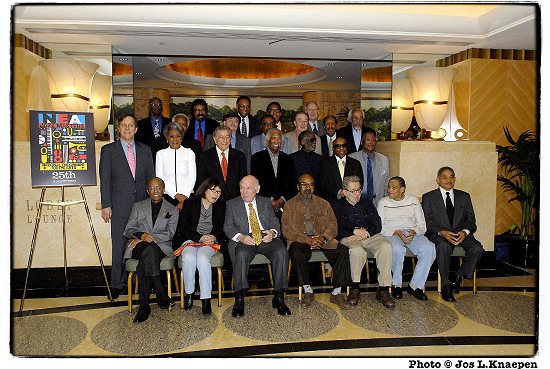
Row 1 (Left to right). Jimmy Heath, Toshiko Akiyhosi, George
Wein, James Moody, Nat Hentoff… Jimmy Scott, Frank Wess.
Row 2: LtR, Dana Gioia, Nancy Wilson, Tony Bennett, Gerald Wilson, Ahmad Jamal,
Roy Haynes, Curtis Fuller
Row 3, LtR: Slide Hampton, Phil Woods, Chico Hamilton, Buddy DeFranco, Ornette Coleman,
Barry Harris.
Row 4, LtR : John Levy, David Baker, Ramsey Lewis, Billy Taylor, Dan Morgenstern
A Glimpse at IAJE Convention Concerts
Written by Jamie Baum, flutist/composer, NYC
Whether your taste is modern jazz, gypsy jazz, fusion, swing or something
in between; big band, small group or piano trio music; marquis names, indie or up-and-coming
talent, you could find them all at the 2007
IAJE Convention held in NYC from January 10 to through 13th at the NY Hilton and
Sheraton Hotels.
Of course, the big name groups performed in the Grand Ballroom evening
concerts and featured the likes of Nancy Wilson, Michel Legrand,
Randy Brecker, Doc Severinsen, the Dizzy Gillespie All-star
Big Band,
Richard Galliano and
Charlie Haden's Liberation Music Orchestra, to name a few.
But if you sifted through the multitude of daily offerings of clinics, panel discussions,
interviews and school receptions there were a host of hour – long concerts offered
throughout each day from 10am until 1:30am. Ranging from high school and college
big bands to all styles of well and lesser-know musicians, the list of almost 100
concerts (I counted them myself!) ranged from Matt Wilson's Art & Craft,
the Dave Liebman
Group, Marvin Stamm Quartet, John Hollenbeck's Large Ensemble,
John Patitucci Quartet, Joanne Brackeen, Charles Tolliver Big Band;
and the list goes on. *
One of the daytime concerts I caught was Gary Thomas' Exile's
Gate that featured the leader on tenor saxophone, George Colligan on
Wurlitzer and John Bollenbeck on guitar. Like altoists Steve Coleman
and Greg Osby, Gary Thomas developed his own fresh approach to improvisation,
avoiding bop clichés and taking solos that are consistently personal and inventive.
In the late '80s, he worked with both Miles Davis and Jack Dejohnette's
Special Edition and recorded frequently with Greg Osby, Michele
Rosewoman, and Wallace Roney, in addition to leading his own sessions.
Despite some sound problems with the balance in the large ballroom that were quickly
worked out, Thomas delivered a hard-driving, high-energy set filled with some odd-metered
groove tunes, lots of chops and interesting solos all around. He played a couple
of tunes by his band–mates and some tunes from his earlier CDs, Found on Sordid
Streets and Pariah's Pariah.
Peter Apfelbaum, a multi-instrumentalist from the bay area though a fixture
on the New York jazz scene for the past several years, performed with his 17-piece
New York Hieroglyphics Ensemble in a well-attended set. He formed the group
in 1977 - his senior year at Berkeley High -
as a vehicle for composing and exploring non-traditional musical forms.
I met Peter many years ago at a ten-day intensive workshop led by The
Art Ensemble Of Chicago held at Karl Berger's Creative Music Studio
in Woodstock, NY. Even then, you could see a real spark of creativity and individuality
in his playing. His approach to music, which transcended style and musical genre,
developed and became more evident in the years he spent working in a wide range
of musical forums. These included Don Cherry's "Multikulti" group, Carla
Bley, David Amram, Eddie Jefferson. Phish frontman Trey Anastasio's
band, to name a few; and he was hired by the legendary singer/activist Harry
Belafonte to arrange and compose music for his 2003
European tour.
I thoroughly enjoyed the concert and it's eclectic, loose, collectively
joyful vibe. The music was well written and the soloists were of a high level, reminding
me that musicians like Peter and Don Cherry were some of the original
purveyors of incorporating "world music" into a jazz and avant-garde framework.
A ritual at the IAJE is to give out awards to both established and up-and-coming
musicians both in performance and composition This year's afternoon opening concert
featured ASCAP awardees "emerging composer" Oscar Perez and "established
composer" Rufus Reid. Cuban rhythms and modern harmonies characterized Perez's
septet composition while Reid's piece written for big band followed a more traditional
style. The Gil Evans Fellowship commission went Sherisse Rogers who
though considered to be emerging talent, has been receiving quite a bit of recognition.
Her big band chart was quite contemporary in feel and reminded of composers John
Hollenbeck and Maria Schneider.
* For a complete list of the conference offering visit
www.iaje.org
Greg Osby interviews Ornette Coleman for
Downbeat
New York, Friday 12nd January 2007
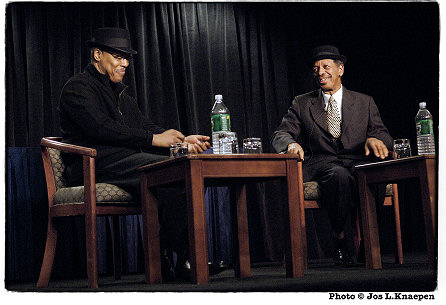
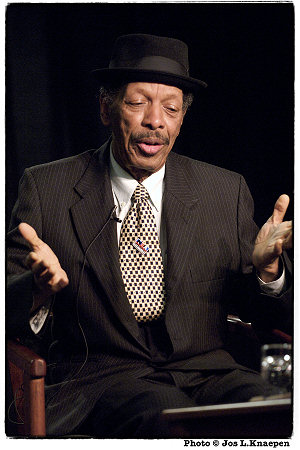
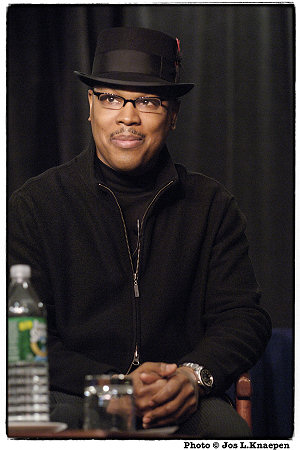
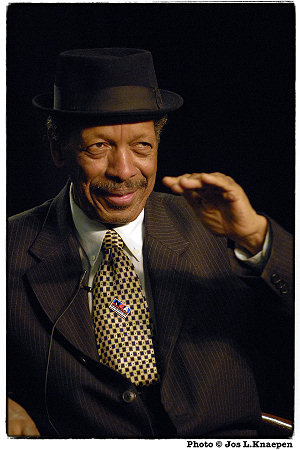
Insert an opinion
|
© 2000 - 2025 All the material published on Jazzitalia is exclusively owned by the author. Moreover it is protected by International Copyright, so it is forbidden any use of it which isn't authorised by the rights' owner.
|
This page has 4.801 hits
Publishing Date: 03/03/2007

|
|

